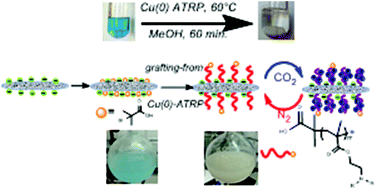Cellulose nanocrystals (CNC) were converted into a CO2-responsive composite nanomaterial by grafting poly(dimethylaminoethy methacrylate) (PDMAEMA) and poly(diethylaminoethyl methacrylate) (PDEAEMA) on its surface using a grafting-from approach via surface-initiated copper(0)-mediated polymerisation (SI-Cu(0)-ATRP). The Cu(0)-ATRP homopolymerisation kinetics of these monomers were first studied to determine suitable conditions to perform the grafting step. Reasonable molecular weight control and livingness were observed during the polymerisations. Following functionalization of the CNC with ATRP initiating groups, a grafting-from approach was employed to graft PDMAEMA and PDEAEMA onto the CNC surface. The surface charge of the graft-modified CNC could be reversibly switched by protonation/deprotonation of the tertiary amine groups simply by sparging with CO2 and N2, respectively.

